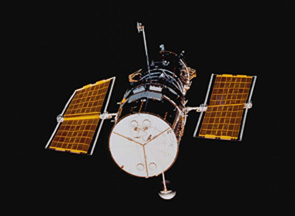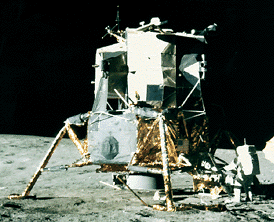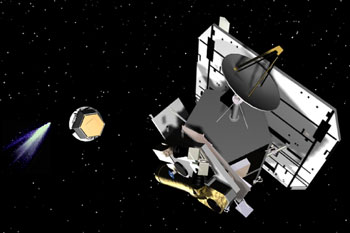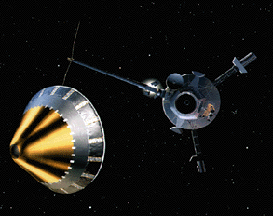Image of Lunar Orbiter spacecraft
NASA/National Space Science Data Center
Lunar Orbiter
During 1966 through 1967, five identical Lunar Orbiter spacecrafts were launched, with the purpose of mapping the Moon's surface and finding smooth, level terrain, in preparation for the Apollo and Surveyor landings.
All five missions were successful. The first three Lunar Orbiters were mostly dedicated to obtaining detailed, high-resolution photographs of 20 areas on the Moon's nearside, preselected as possible future landing sites. Lunar Orbiters 4 and 5 concentrated on more general mapping, covering 99% of the lunar surface including most of the farside. Also, much was learned about the Moon's gravitational field.
After orbiting the Moon and returning hundreds of photographs, each Lunar Orbiter spacecraft was commanded to crash into the surface, destroying itself.
You might also be interested in:

The Surveyor missions of 1966 through 1968 were the next step in space travel to the Moon, following the Ranger missions. Their goal was to perform "soft" landings on the lunar surface, meaning that the
...more
Driven by a recent surge in space research, the Apollo program hoped to add to the accomplishments of the Lunar Orbiter and Surveyor missions of the late 1960's. Apollo 11 was the first mission to succeed
...more
The Hubble Space Telescope (HST) was one of the most important exploration tools of the past two decades, and will continue to serve as a great resource well into the new millennium. The HST is credited
...more
Apollo 12 survived a lightning strike during its launch on Nov. 14, 1969, and arrived at the Moon three days later. Astronauts Charles Conrad and Alan Bean descended to the surface, while Richard Gordon
...more
Apollo 15 marked the start of a new series of missions from the Apollo space program, each capable of exploring more lunar terrain than ever before. Launched on July 26, 1971, Apollo 15 reached the Moon
...more
NASA chose Deep Impact to be part of a special series called the Discovery Program on July 7, 1999. In May 2001, Deep Impact was given the "go" from NASA to start with mission development. Deep Impact
...more
The Galileo spacecraft was launched on October 19, 1989. Galileo had two parts: an orbiter and a descent probe that parachuted into Jupiter's atmosphere. Galileo's primary mission was to explore the Jovian
...more















